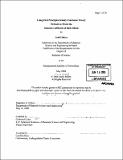Using first principles Destiny Functional Theory methods to model the Seebeck coefficient of bulk silicon
Author(s)
Mehra, Saahil
DownloadFull printable version (7.848Mb)
Other Contributors
Massachusetts Institute of Technology. Dept. of Materials Science and Engineering.
Advisor
Gerbrand Ceder.
Terms of use
Metadata
Show full item recordAbstract
Thermoelectrics are gaining significant amounts of attention considering their relevance today in the areas of sustainable energy generation and energy efficiency. In this thesis, the thermoelectric properties of bulk Silicon were modeled using ab initio density functional theory methods to determine the Si band structure. Specifically, three different models for determining the Seebeck coefficient - Parabolic Bands, Boltzmann's theory, and the 'Pudding Mold' approximation to Boltzmann's theory - were studied in depth and compared with experimental values. Here we show first principles calculations to yield Seebeck coefficients for n-type Silicon to be on the order of 300 gtV/K at -300 K, and -500 gtV/K at 300 K for the Parabolic Bands and Boltzmann approach, respectively. While the 'Pudding Mold' Theory failed in its approximations of the Seebeck coefficients, the calculations using the other two theories were found to agree closely with experimentally determined Seebeck coefficients.
Description
Thesis (S.B.)--Massachusetts Institute of Technology, Dept. of Materials Science and Engineering, 2008. Includes bibliographical references (leaves 27-28).
Date issued
2008Department
Massachusetts Institute of Technology. Department of Materials Science and EngineeringPublisher
Massachusetts Institute of Technology
Keywords
Materials Science and Engineering.